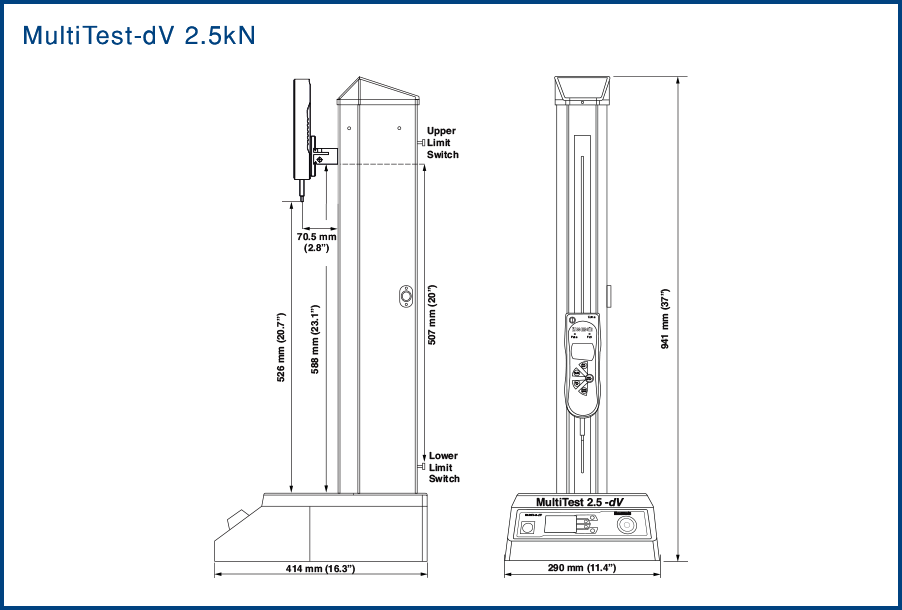1 MultiTest-dV Tension and Compression Test Stand Operating Manual
 |
431-459 September 2022 |
2 Introduction
VectorPro™, VectorPro™ MT and VectorPro™ Lite are all registered trademarks of Mecmesin Ltd.
This document refers to Mecmesin MultiTest-dV test stands operating with the latest firmware version.
The following manuals may aid you in the use of your test stand:
|
Mecmesin Long Travel Extensometer Installation Guide (431-969) |
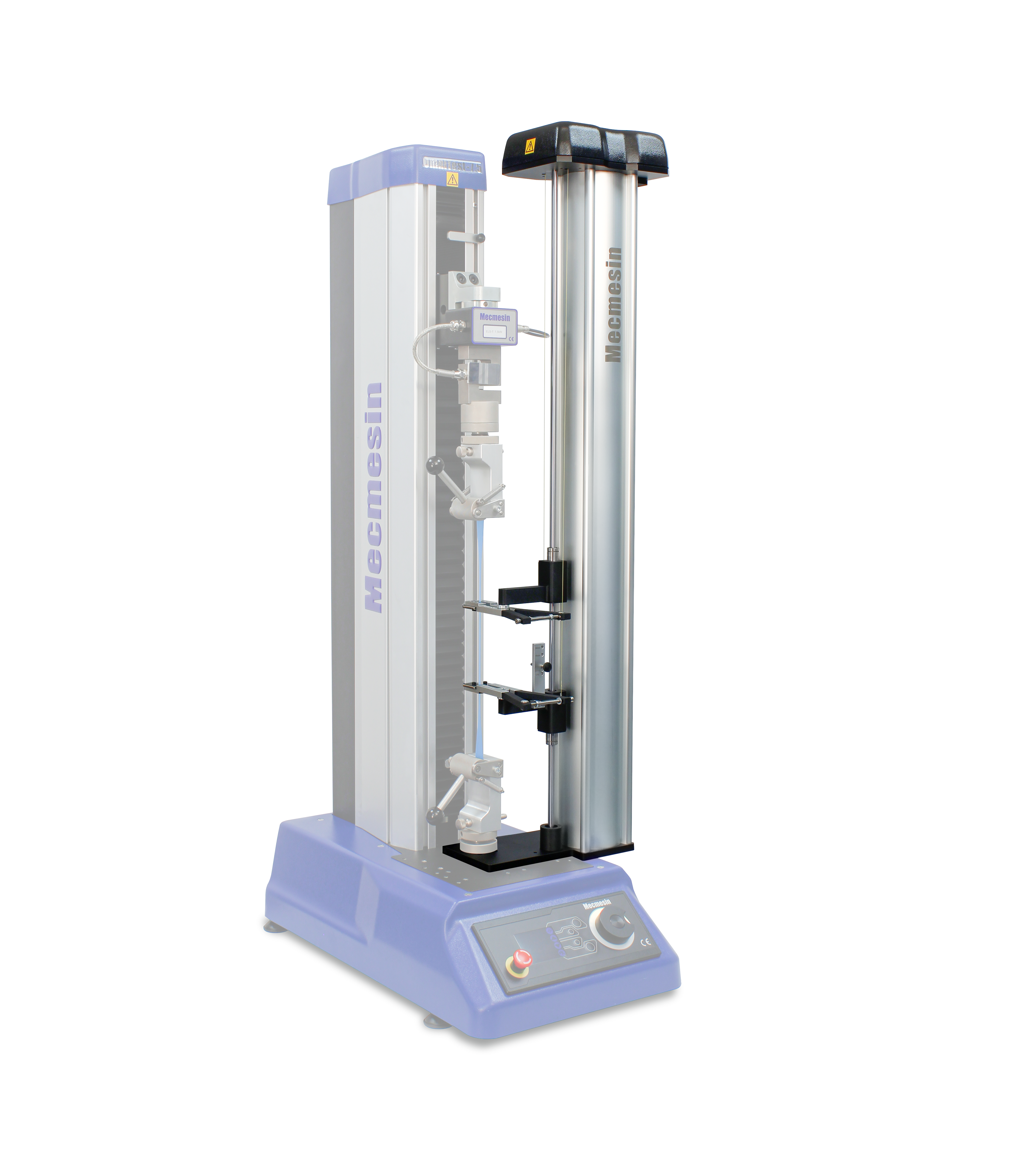 |
 |
VectorPro™ User Manual - Introduction and Initial Setup (431-955) |
|
Advanced Force Gauge (AFG Mk4) Operating Manual (431-213) Runs through the operation of Advanced Force Gauge in conjunction with MultiTest-dV test stands. |
|
Installation & Operation of Mecmesin Interlocked Machine Guarding (431-971) Covers the operation and function of all Mecmesin interlock enabled machine guarding. |
2.1 User Manual Icons
Throughout this manual, the icons shown below are used to identify important health and safety information as well as additional installation/operation guidance. Do not proceed until each individual message is read and thoroughly understood.
2.1.1 Warning
2.1.2 Caution
2.1.3 Information
- 1 MultiTest-dV Tension and Compression Test Stand Operating Manual
- 2 Introduction
- 3 System Diagram
- 3.1 Identifying a MultiTest-dV Mark or Version
- 6.1 Moving the Test Stand
- 6.2 Mains Power Supply
- 6.3 Fuse Specification
- 6.4 Fitting the Feet to the Stand
- 6.5 Bolting the Test Stand to the Work Surface
- 6.6 Fitting and Connecting an AFG digital force gauge
- 6.7 ELS - Enhanced Load Sensor
- 6.8 Connect the Test Stand to a PC (VectorPro Users Only)
- 6.9 Cable Management
- 6.10 Attaching Grips and Fixtures
- 6.11 Setting the Limit Stops
- 6.12 Test Stand States
3 System Diagram
3.0.1 Front View
| 1 | Upper and Lower safety limit switches (located at the rear of column) |
|---|---|
| 2 | Moving crosshead (dovetail mount for AFG or ELS) |
| 3 | Font panel control |
| 4 | Emergency stop button |
| 5 | Multi-function scroll wheel and menu selection button |
| 6 |
ELS connection socket (ELS 1) |
3.0.2 Rear View
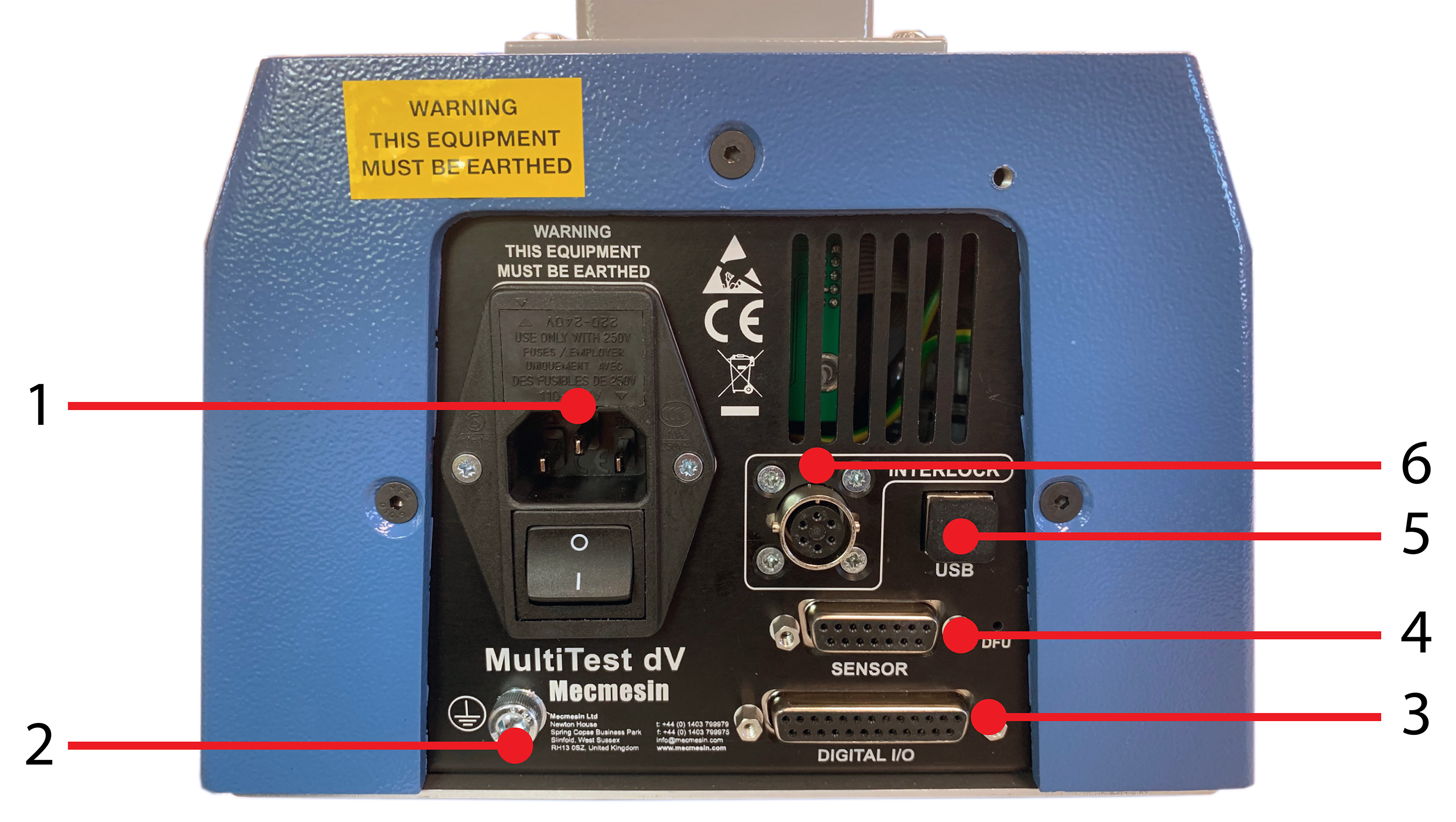
| 1 | Mains connection and Inlet Filter (contains voltage selector and fuse holder) |
|---|---|
| 2 | System earth point |
| 3 | Digital I/O port (not currently implemented) |
| 4 | Sensor input port (currently for ELS 2 + 3 or AFG) |
| 5 | USB connection for PC control using VectorPro™ software |
| 6 | Interlock connection port |
3.1 Identifying a MultiTest-dV Mark or Version
3.1.1 Mark 1
MultiTest-dV Mark 1 machines are the original motorised test stands developed for use with the AFG digital force gauge only. These are controlled by VectorPro™ Lite software functionality. These stands were produced up to November 2017 and will have formatted serial numbers up to 17-XXXX-11.
3.1.2 Mark 2
MultiTest-dV Mark 2 machines have hardware advancements, to optionally provide dV(u) functionality.
This enhances the system and adds an additional materials test capability, controlled by VectorPro™ MT software functionality.
These stands were produced between November 2017 and March 2020. They will have formatted serial numbers between the range 17-XXXX-11 and 03-XXXX-20. Compatible Mark 2 MultiTest-dV test stands are identified through two key elements:
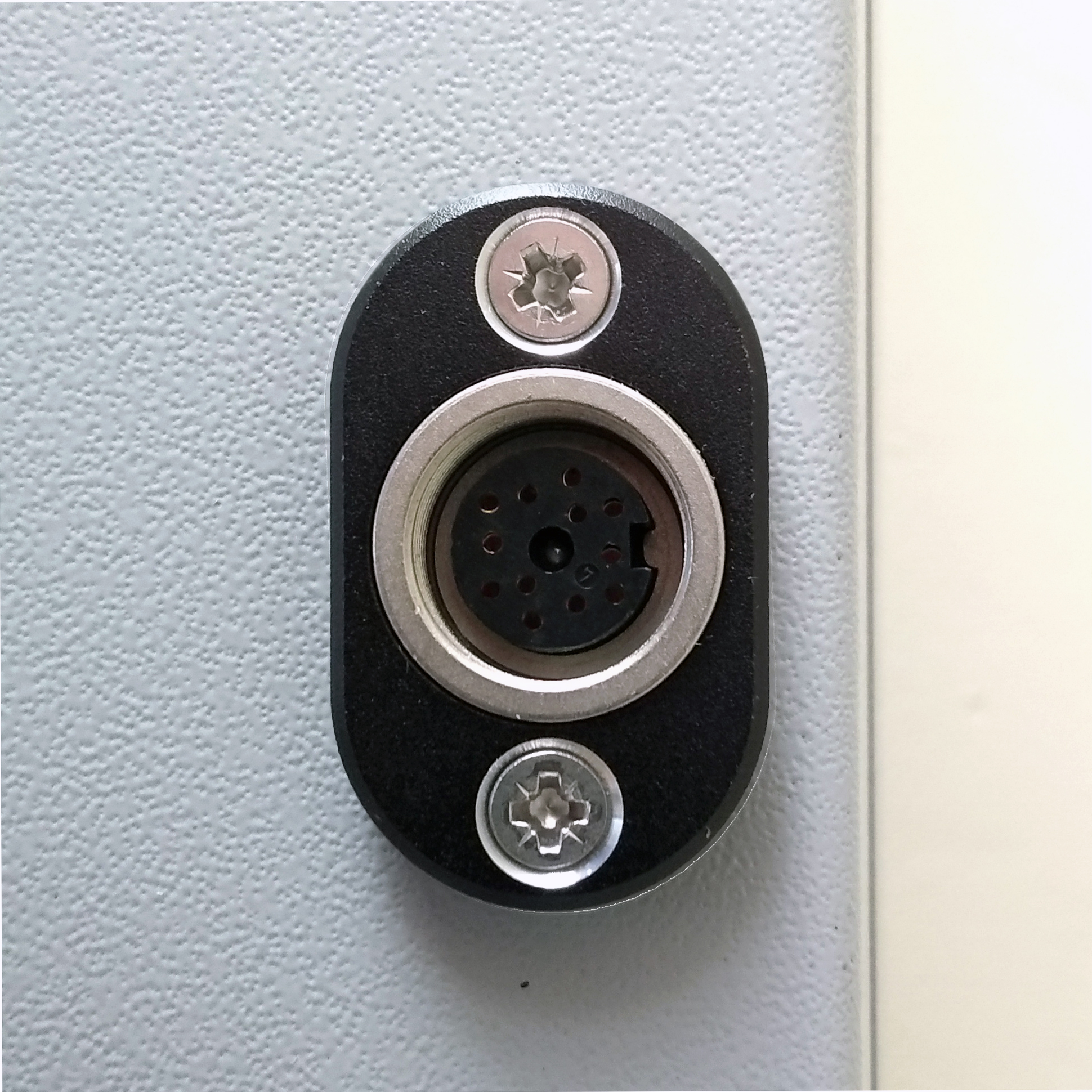
All Mark 2 MultiTest-dV test stands have an ELS port, located centrally in the column shroud on the right-hand side.
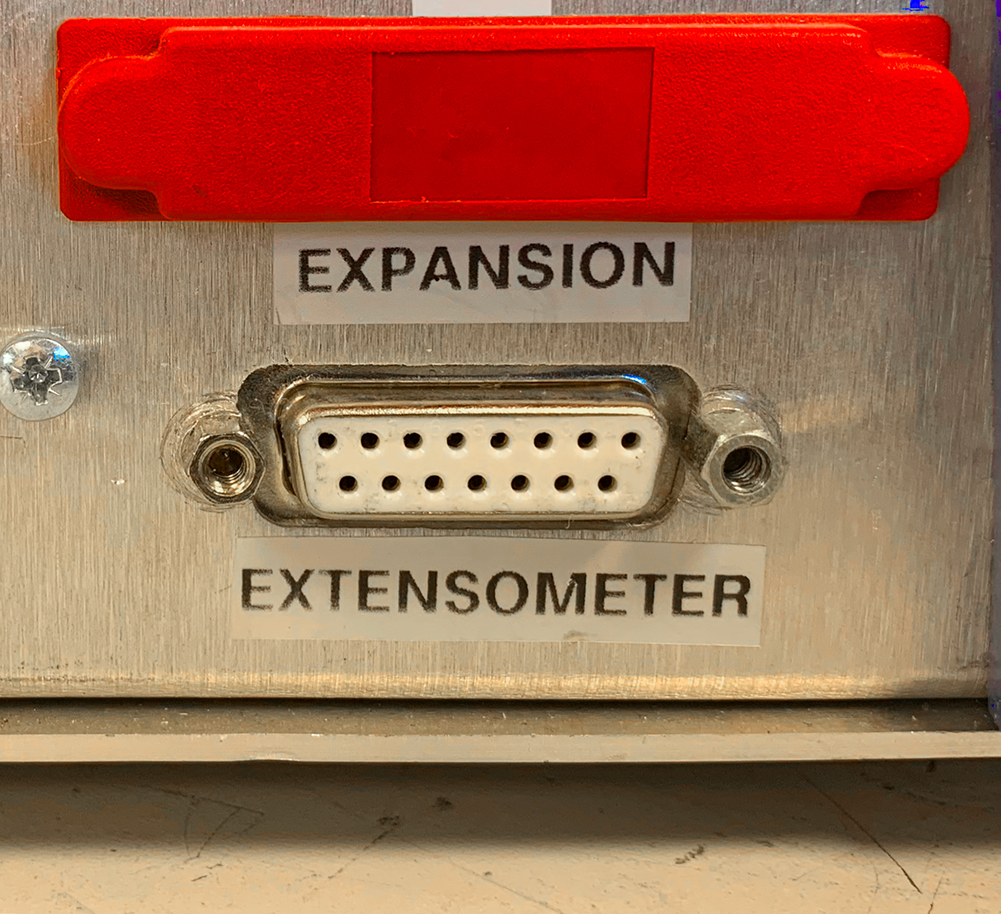
An 'Extensometer' 15 pin connection port is fitted to the rear of the stand.
3.1.3 Mark 2 - Interlock Enabled
The Mark 2 Interlock enabled machine is very similar to the Mark 2 model, but it includes hardware capable of supporting a Mecmesin supplied safety guard.
These machines are produced to date from April 2020 and have the formatted serial numbers starting from 04-XXXX-20. See the Interlocked Guarding Overview section for more detail.
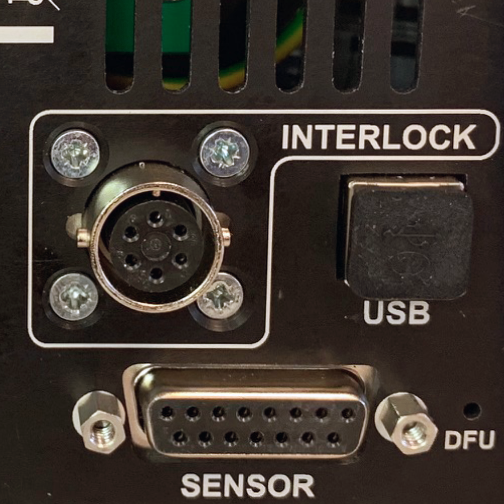
All Mark 2 Interlock enabled MultiTest-dV test stands have an 'Interlock' and a 15 pin 'Sensor' connection on the rear stand panel.
4 Unpacking and Parts Supplied
4.1 Inspection and Unpacking
Before installing or operating the MultiTest-dV system ensure that no visible damage has occurred during the shipping of the device.
4.2 Packaging
We strongly recommend that the packaging is retained, as this can be useful if the machine needs to be returned for calibration or shipped to another location.
Parts Supplied with the Test Stand, details the parts that should be included with your test stand. Please contact Mecmesin or your authorised distributor if any items are missing or damaged.
4.3 Moving the Test Stand
4.4 Parts Supplied
Please see the table below for the list of the parts supplied with the MultiTest-dV system:
| Item | Quantity |
|---|---|
| MultiTest-dV test stand (0.5, 1.0 or 2.5 kN), | 1 |
|
Dovetail gauge bracket (for fitting a gauge to the crosshead), |
1 |
| Interlock override plug, | 1 |
| Allen key for tightening crosshead to gauge bracket, | 1 |
| Mains cable, | 1 |
| Document: A Guide to Safe Use of Mecmesin Mains Powered Test Systems, | 1 |
| Document: Online Manual Information Guide | 1 |
4.5 Accessories
For a full range of digital force gauges, ELS devices, extensometers and accessories, please go to the Mecmesin website: help.mecmesin.com, or contact your local distributor.
- For connection of the stand to your computer, a Mecmesin supplied 2m USB-B to USB-A cable communications cable is required, (part no. 351-093),
- When using a MultiTest-dV Mk1 or Mk2 stand and a Mecmesin Advanced Force Gauge (AFG), use communications cable (part no. 351-092) to connect the gauge to the test stand,
- When using a MultiTest-dV Mk2 Interlock enabled stand and a Mecmesin Advanced Force Gauge (AFG), use communications cable (part no. 351-103), to connect the gauge to the test stand.
5 Dual Functionality
MultiTest-dV Mark 2 test stands, with firmware version 3.0.2 and above, can operate in both standard dV mode and also dV(u) mode to allow support of ELS and extensometry devices, in conjunction with the latest VectorPro software.
By default, all Mark 2 MultiTest-dV test stands are supplied in dV mode, to switch the test stand to dV(u) mode both VectorPro and a dV(u) license key are required, these can both be ordered separately from your local Mecmesin distributor.
5.1 Functionality Differences between dV and dV(u) modes
The table below highlights features unique to each of the MultiTest-dV’s operating modes:
|
In dV Mode |
In dV(u) Mode |
|---|---|
|
Supports AFG/AFTI gauges only |
Supports ELS devices only |
|
Supports stand-alone testing option |
VectorPro required for all testing |
|
Supports cyclic testing |
Extensometer support |
|
Single operation |
Multiple configurable operations within VectorPro |
|
Force limit control |
SDC support |
|
Suitable for basic product testing |
Suitable for basic material testing |
5.2 Switching Modes
To switch to dV(u) mode, a dV(u) key is required, along with a test stand with firmware version 3.0.2 or later and the latest VectorPro software version. The dV(u) key is a separate accessory and can be purchased from your local Mecmesin agent (part number: 840-425).
To switch the stand into dV(u) mode first open VectorPro. Once the workspace screen is displayed, click the USB icon located in the top left of the screen (circled in red below). Next, click the button highlighted in green in the image below. If a corresponding dV(u) key is present the stand will enter dV(u) mode.
Pressing the button, highlighted in green above, switches the stand into dV(u) mode.
In the screenshot above the stand is currently in dV mode. This is illustrated by the AFG connected to the stand and by the stand name located within the switch button.
The image above shows the device in dV(u) mode. This is illustrated by the connected ELS in the image, as well as the ELS device information in the main panel.
To switch from dV(u) to dV mode, open the device information panel within VectorPro and click the switch located at the bottom of the panel (Shown below).
5.3 License Keys
A VectorPro Lite license key is required to run a MultiTest-dV test stand, fitted with an AFG gauge and VectorPro software.
6 Initial Setup
6.1 Moving the Test Stand
6.2 Mains Power Supply
MultiTest-dV test stands can be used on 110–120 or 220–240 Vac 50-60 Hz supplies. The rear fuse carrier is set for the local voltage requirement, but is reversible. Should a fuse be replaced, ensure that the correct local voltage is selected.
The voltage that is selected is indicated by which the arrow is pointing to the white line located at the bottom of the device. This is illustrated in the image below, shown within the red circle:
6.3 Fuse Specification
MultiTest-dV test stands use two 2A - Time-delay (T), 5 x 20mm fuses. If replacing a blown fuse, replace only the fuse on the active side of the inlet filter with the fuse specified above, or equivalent.
6.4 Fitting the Feet to the Stand
The MultiTest-dV 2.5kN is supplied with four rubber feet. Support the stand and fit the four rubber feet to the base of the stand using an appropriate screwdriver.
For MultiTest-dV, 0.5kN and 1.0kN test stands it is recommended that the system is mounted to a suitable work surface using the supplied bench mount adapters. Please see the next section for more information.
6.5 Bolting the Test Stand to the Work Surface
|
Test Stand Capacity (kN) |
Height (Mm) |
Feet/Fixing Supplied |
Bolting Recommended |
|---|---|---|---|
|
0.5 |
1616 |
Anchor brackets |
Yes |
|
1 |
1416 |
Anchor brackets |
Yes |
|
2.5 |
941 |
Rubber feet |
No |
The extended-length test stands (MultiTest 0.5-dV and MultiTest 1-dV) are supplied with base anchoring brackets to allow the test stands to be bolted to a bench.
Screw the anchoring brackets to the four positions on the base plate of the MultiTest 0.5-dV or 1-dV using the M6 screws provided (Shown below). Secure the test stand to the bench using suitable fasteners.
6.6 Fitting and Connecting an AFG digital force gauge
The MultiTest-dV has a dovetail bracket attached to the moving crosshead. This is used to mount AFG devices.
To fit an AFG, first attach the AFG mounting bracket (part no. 432-427) to the back of a Mecmesin AFG or AFTI digital force gauge.
Then slide the gauge sideways onto the dovetail and secure it by tightening the dovetail screw with an Allen key.
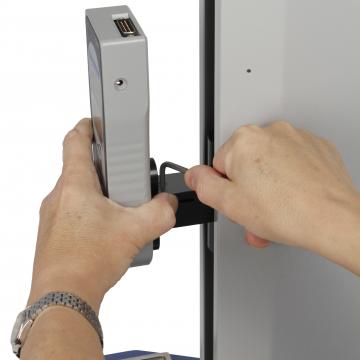
6.6.1 Connecting an AFG to the MultiTest-dV
6.6.1.1 Mark 1 or Mark 2
For MultiTest-dV (Mark 1 or Mark 2), a Mecmesin AFG digital force gauge is connected to the test stand using cable (part no. 351-092). Connect the 15-pin D connector to the top socket of the AFG, and the opposite end of the cable to the RJ11 plug (marked 'Gauge'), located on the rear of the stand:
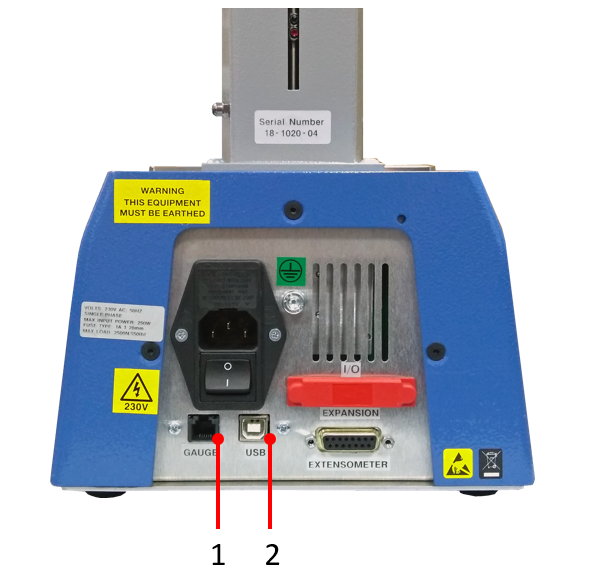
| 1 | RJ11 connection for AFG digital force gauge |
|---|---|
| 2 | USB-B connection for PC (VectorPro software only) |
6.6.1.2 Mark 2 Interlock Enabled
For MultiTest-dV Mark 2 Interlock Enabled stands, a Mecmesin AFG digital force gauge is connected to the test stand using cable (part no. 351-103). Connect the 15-pin D connector to the top socket of the AFG, and the opposite end of the cable to the Sensor connection located on the rear of the stand:
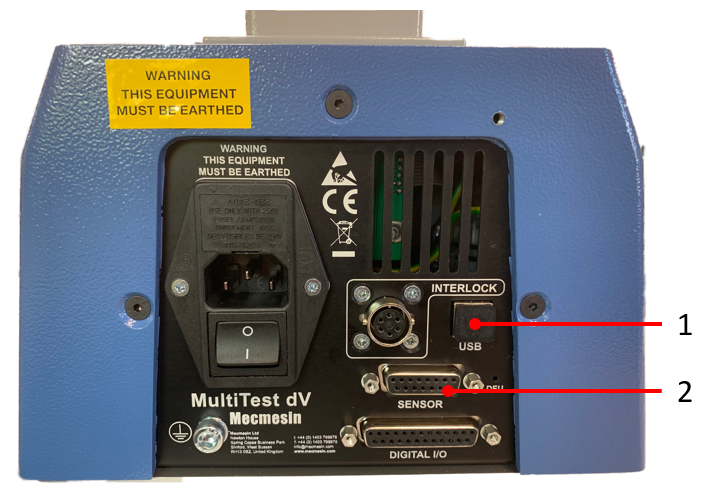
| 1 | USB-B connection for PC (VectorPro software only) |
|---|---|
| 2 | 15 pin Sensor connection for AFG digital force gauge |
6.6.2 AFG communication settings
To achieve communication between a MultiTest–dV test system and an AFG device you need to apply the correct settings within the AFG’s communication menu. The following AFG buttons are used in the instruction below:
| AFG Button | Button Name |
|---|---|
 |
UNITS/MENU |
 |
ZERO/DOWN |
 |
RESET/ENTER |
 |
MAX/ESC |
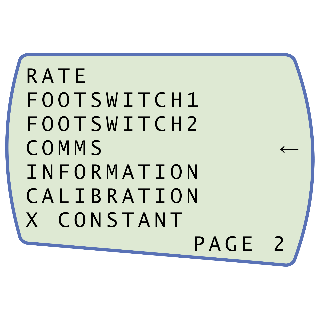
Press 'UNITS/MENU' once to continue to menu page 2, as shown in the image above.

Scroll down using the 'ZERO/DOWN' button, then press 'RESET/ENTER' to select the 'COMMS' menu.

Now press 'RESET/ENTER' on 'PORT'.
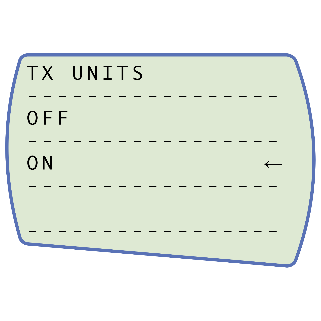
Set 'TX UNITS' to 'ON', press 'RESET/ENTER' to continue.
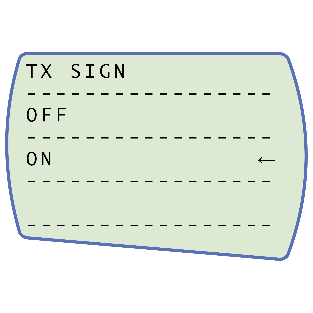
Set 'TX SIGN' units to 'ON', press 'RESET/ENTER' to continue.

Set the baud rate to '115200', press 'RESET/ENTER' to continue.
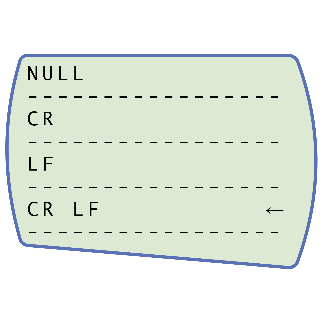
Set 'CR LF', press 'RESET/ENTER' to continue
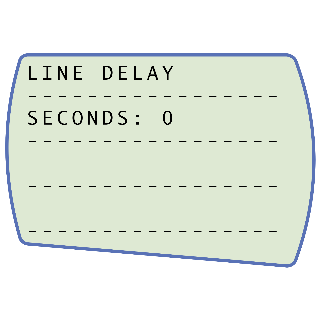
Ensure the line delay is set to '0', press 'REST/ENTER' to continue.

Ensure the TX threshold is set to '0', press 'REST/ENTER' to continue.
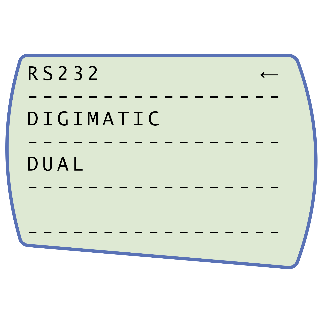
Set 'RS232', press 'RESET/ENTER' to continue.
6.7 ELS - Enhanced Load Sensor
Enhanced load sensors or 'ELS' for short, are smart devices used to capture load readings for MultiTest-dV test stands operating in dV(u) mode.
All calibration information is held in the individual load cell's electronic memory, meaning the ELS can be swapped from system to system and the calibration will follow.
These load cells are available in a range of sizes and designs to best suit your requirements. See the MultiTest-dV Specification section of this document for details relating to capture rate and accuracy.
6.7.1 Fitting an ELS to a Test stand
To fit an ELS to the test stand, slide the load cell sideways onto the dovetail mounting. Then tighten the grub screw (circled below in red), located on the top of the dovetail mounting, using a suitable Allen key.
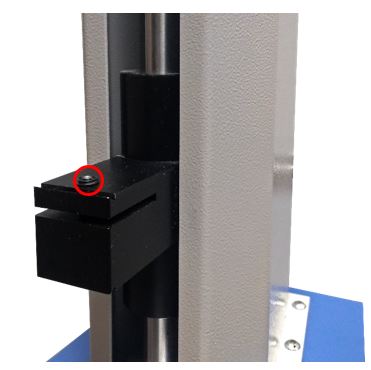
6.7.2 Connecting an ELS to the MultiTest-dV(u)
ELS devices connect to MultiTest-dV(u) test stands using a 6-pin to 12-pin connector cable. This connects to the ports located on the side of the ELS body (6-pin) and the test stands column (12-pin), as seen in the image below.

6.8 Connect the Test Stand to a PC (VectorPro Users Only)
When using VectorPro software, connect the USB-B port, located on the rear panel of the test stand, to the accompanying PC using cable (part no. 351-093).
| Important! Please install VectorPro software on the assigned PC before connecting the test stand to that computer. Once the software is installed and the stand is connected, the stand will show as connected. This is shown in the image to the right. |  |
6.9 Cable Management
6.10 Attaching Grips and Fixtures
For flexibility, attachment of a variety of accessories and improved alignment, the MultiTest-dV is fitted with an anvil plate. This plate will accept fixtures with different screw threads (5/16, 10/32 and M6), as well as fixing points for a standard 20mm 'type C' - QC adapter.
This anvil plate is attached with four bolts using an Allen key. For alignment, the anvil plate can be loosened, moved forwards or back, and the bolts retightened.
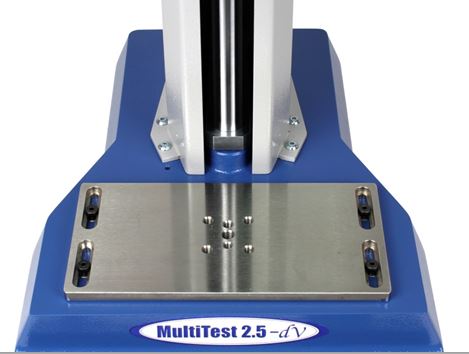
Upper grips and accessories are attached directly to the ELS device being used.
6.11 Setting the Limit Stops
'Limit stops' help prevent damage to load cells and fixtures by interupting the crosshead movement before any moving parts or fixtures can come into contact with static parts of the stand. Their positions are adjusted after the fitting of fixtures and test samples.
There are two manually set limit stops, located on the rear column of the MultiTest-dV. These are set by loosening the thumbscrew, moving the stop to a new position and retightening. When the crosshead meets a stop, it activates a switch. This stops the crosshead movement at an upper or lower limit.
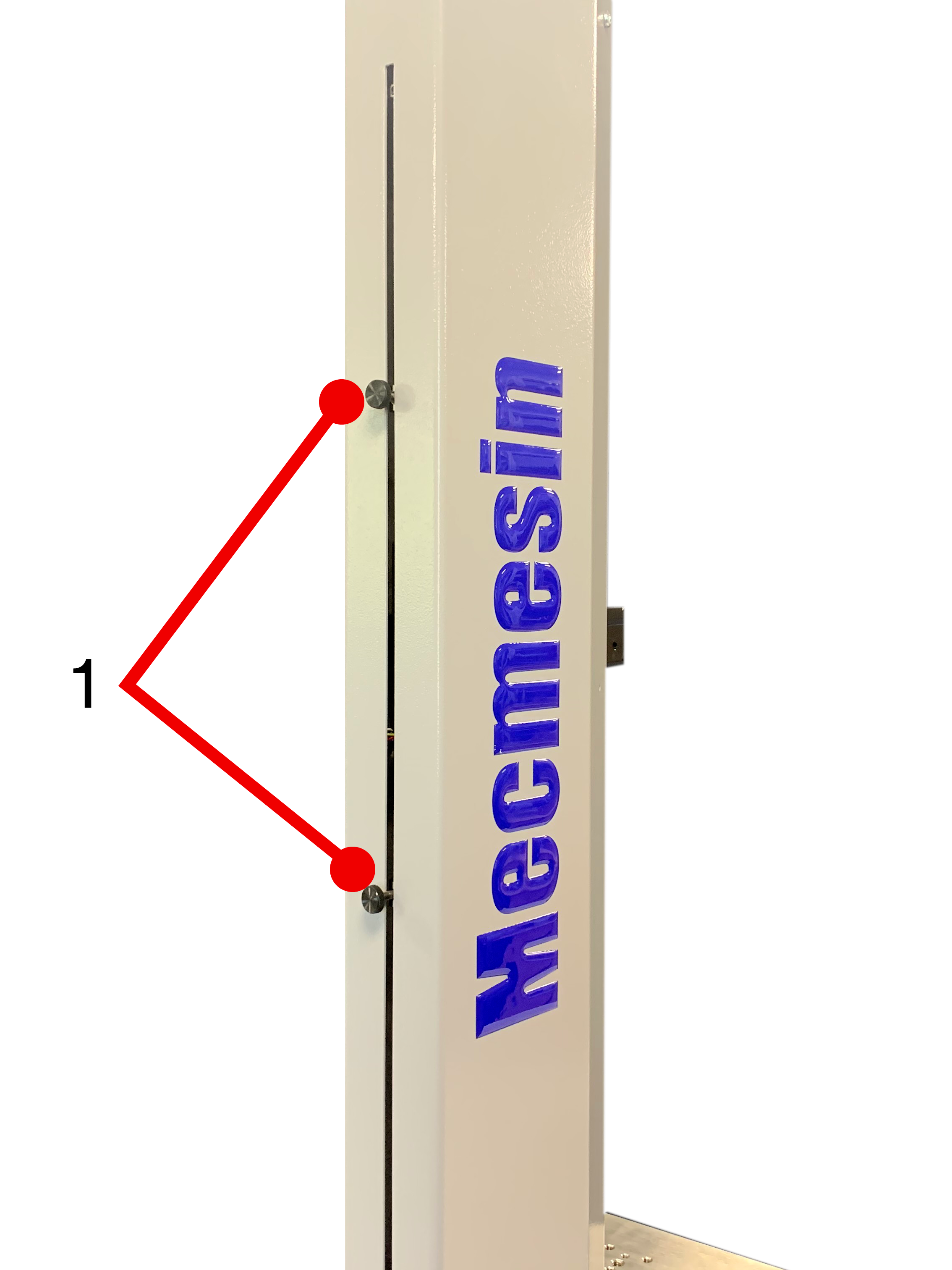
| 1 | Upper and Lower Limit Stops |
|---|
6.12 Test Stand States
The test stand can be in one of five states:
- Test readiness - ready to start, or complete,
- Testing – test operation sequence is running,
- Stopped - test interrupted or emergency stop pressed,
- Jog mode - for jogging or positioning the crosshead manually,
- Settings menu – for adjusting your test stands settings,
In each state, the selector buttons have functions described by the on-screen icons.

|
1 |
Status messages and information |
|---|---|
| 2 | Button function icons |
| 3 | Multi-function selection buttons |
| 4 | Multi-function scroll wheel |
| 5 | Scroll wheel button (used in function menus) |
| 6 | LED dial status ring |
| 7 | Colour display |
| 8 | Emergency Stop button |
7.1 Emergency Stop Button
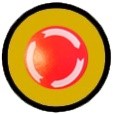 |
Push to stop the crosshead movement. Rotate the button to release it and resume crosshead control. If pressed during a test, do not restart a test, ensure you remove any residual force using the test stand’s jog controls. |
7.2 Multi-function Scroll Wheel Control
7.2.1 Scroll Wheel Colours
The lights surrounding the wheel illuminate in three colours, indicating the status of the test stand:
 |
 |
 |
| Colour | Status | Indication |
|---|---|---|
| Green | Pulsating | Ready to start a test |
| Green | Rotating | Scrolling through menus |
| Green | Flashing | Test completed |
| Amber | Static | In jog mode menu |
| Amber | Rotating | Crosshead moving |
| Red | Static | Test aborted / limit triggered |
7.2.2 Jog Mode
When in jog mode, the scroll wheel drives the crosshead up (clockwise turn) or down (anticlockwise turn). This method offers more variable control when compared to the two fixed-speed jog control buttons (circled in red below).
| 1 | Enter Jog Mode |
|---|---|
| 2 | Jog keys up and down |
The scroll wheel can also be used as a speed controller. The jog buttons move the crosshead at the set speeds (configured in the ‘Jog Settings’ menu picture below).
Rotating the wheel clockwise while holding a jog button increases the speed and rotating the wheel anticlockwise while holding a jog button decreases the speed.
MultiTest-dV test stands also feature a 'precision jog mode'. Rotating the scroll wheel while holding in the central scroll wheel button moves the test stand at its minimum speed, this is useful when fitting specimens into grips or if precision positional control is required.
7.2.3 Navigational Control
The scroll wheel can also be used to navigate the menus. When in a selection menu, the scroll wheel cycles through the selections and their values. This is an alternate navigational option to using the up and down arrow buttons.
7.2.4 Central Button
The central button is used to confirm a menu selection. It is equivalent to selecting the tick button function.
7.3 MultiTest-dV Display Panel
The display indicates the stand’s status, displays live values and is used to configure the test stand's settings.
The purpose of the four multi-function buttons is indicated on-screen by an adjacent icon. Below is an image showing a typical example of the on-screen icons in relation to the physical buttons.
| 1 | The top icon is 'Confirm' |
| 2 |
The mid-upper icon is 'Up' |
| 3 | 'Menu selection' buttons |
| 4 | The mid-lower icon is 'Down' |
| 5 | The bottom icon is 'Back/Exit' |
7.4 On-Screen Icons
On-screen icons vary depending on the current state of the test stand. What functions the physical buttons perform at that point, depends upon which menu is currently displayed. Below are reference tables to help explain the icon definitions, in relation to the test stand state.
7.4.1 Pre-Test
|
Icon |
Action |
|
No AFG connected / No ELS connected (if in dV(u) mode). |
|
| Start a test sequence | |
|
Enable jog mode |
|
| Go to settings | |
| Move to the home position (Set within VectorPro or test start position) |
7.4.2 During a Test
|
Icon |
Action |
|
Pause test (MultiTest-dv only) - This stops the crosshead movement, leaving the stand in a state of test readiness. The status message is ‘Interrupted: User’ and the 'Play' and 'Stop' buttons will be displayed. |
|
| Stop test (MultiTest-dV(u) only) - This will abort the current test running (including the VectorPro MT software). The status message is 'Test aborted' and the 'Home' and 'Exit' buttons will be displayed. | |
 |
Emergency stop button pushed: Message: ‘Emergency Stop!!!’. Release the emergency stop to regain control and remedy the situation before resuming testing. Note there is no on-screen icon for the emergency stop. |
|
Upper limit switch triggered - The crosshead has reached the upper travel limit, as set by the MultiTest-dV’s limit switches, and stopped. Further travel in this direction is prevented. |
|
|
Lower limit switch triggered - The crosshead has reached the lower travel limit, as set by the MultiTest-dV’s limit switches, and stopped. Further travel in this direction is prevented. |
7.4.3 Paused/Stopped
|
Icon |
Action |
|
(MultiTest-dV) - Continue test sequence. (MultiTest-dV(u)) - Used in conjunction with the 'Pause' timeline operation in VectorPro MT software, to acknowledge requested message and continue test sequence. |
|
|
Stop test (MultiTest-dV only) - Shown when the Pause button is pressed. This ends the test at this point |
|
|
Move to the home position (start position from the beginning of the previous test) -This icon is only visible after pressing the 'Stop' button. |
|
|
Exit to the test ready screen, leaving the crosshead in its current position - This icon is only visible after pressing the 'Stop' button. |
7.4.4 Jog Mode
|
Icon |
Action |
|
Zero (tare) all system values. |
|
|
Move the crosshead upward at the set jog speed. |
|
|
Move the crosshead downward at the set jog speed. |
|
|
User Warning! Crosshead has reached an upper limit (load signal from a connected gauge, set to Stop, or a limit switch) and stopped. |
|
|
User Warning! Crosshead has reached a lower limit (load signal from a connected gauge, set to Stop, or a limit switch) and stopped. |
7.4.5 Settings Menu
|
Icon |
Action |
|
Confirm selection (or press the centre scroll wheel button). |
|
|
Navigate up a menu selection or value (or turn the wheel clockwise). |
|
|
Navigate down a menu selection or value (or turn the wheel anticlockwise). |
|
|
Go back to the previous screen. |
8 Settings
8.1 MultiTest-dV Operation

The settings listed below are for a MultiTest-dV being used in dV mode, as shown in the image above, for dV(u) operation see section Settings - MultiTest-dV(u) Operation.
8.1.1 Jog settings
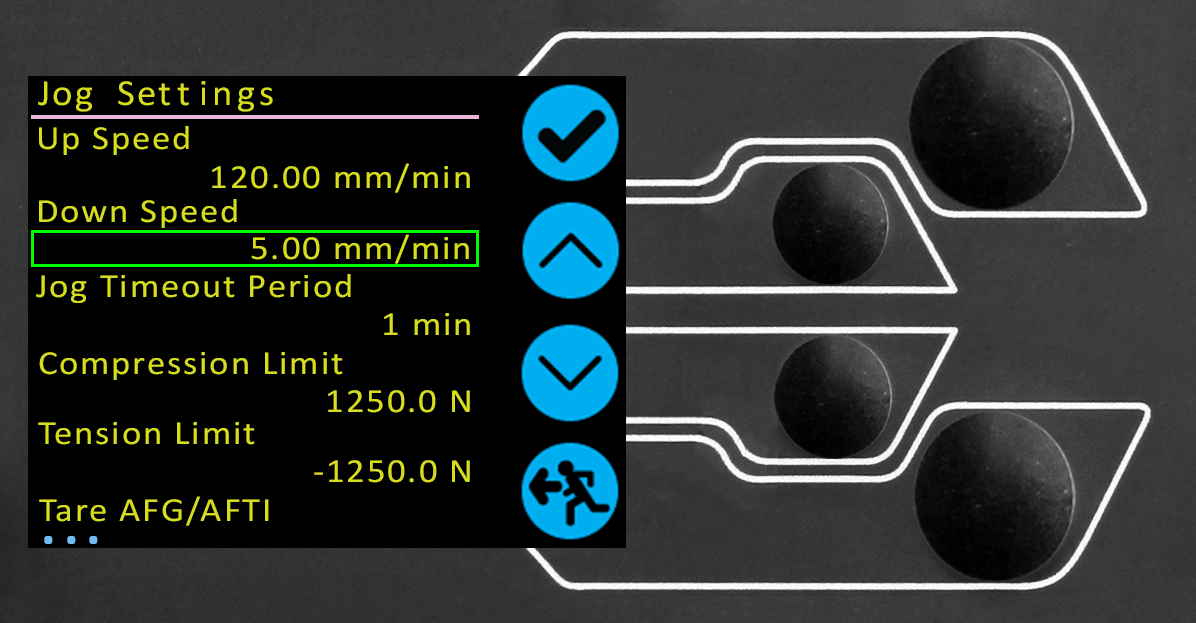
Within the jog settings menu (pictured above), configuration of the jog speed limits while in jog mode, can be set. Below is a detailed breakdown of each setting and the options available for each setting.
|
Setting |
Action |
Range |
|---|---|---|
|
Up Speed |
Configure the jog speed in an upward motion |
0.1 to 1200 mm/min 0.004 to 47.2 Inch/min |
|
Down Speed |
Configure the jog speed in a downward motion |
0.1 to 1200 mm/min 0.004 to 47.2 Inch/min |
| Jog Timeout Period |
Set the timeout (in minutes) that the machine will keep the motor drive engaged, before the motor drive is disabled. The load applied to the AFG and stand, must reach at least 25 % of the test stand's capacity before the timeout activation is applied. At the end of the timeout period, the 'Jog Active' menu screen is automatically switched back to the 'Ready to Test' menu screen. (Example: MultiTest-dV 2.5 kN stand fitted with a 1 kN AFG, must reach 625 N in Tension or Compression, before the timeout activation is applied. Forces below the 25 % limit will not activate the timeout and the stand will actively hold the load applied. |
1 to 59 minutes |
|
Tension Limit |
Configure the tensile force limit while in jog mode |
0 to +200 N |
|
Compression Limit |
Configure the compressive force limit while in jog mode |
0 to -200 N |
|
Tare AFG/AFTI |
Configure whether or not the AFG/AFTI maximum or minimum reatined value is tared when pressing the tare button in jog mode or starting a test. |
Yes or No |
8.1.2 Units
Within the units menu, the test stands units for displacement and speed can be configured. Force units are configured using the AFG.
|
Setting |
Units Available |
|---|---|
|
Displacement |
mm, in |
|
Speed |
mm/min, mm/sec, in/min, in/sec |
|
Force |
N, gf, kgf, ozf, lbf, mN, kN |
8.1.3 Edit Test (Including VFG/VFTI)
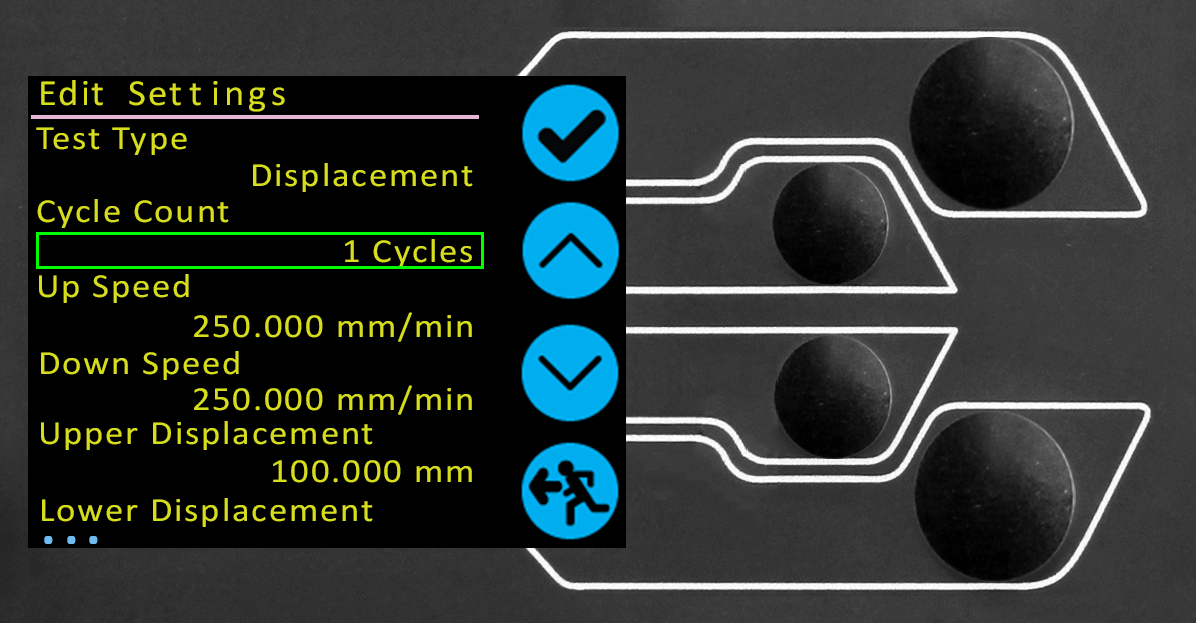
The 'Edit Test' menu, as shown above, allows configuration of the MultiTest-dV's test settings.
8.1.3.1 Displacement Control
In a displacement test, the crosshead moves between two reference points that are relative to tared zero. Ensure that the limit switches allow the required travel.
|
Setting |
Options |
|---|---|
|
Cycle Count |
0-9999 |
|
Up Speed |
0-1200mm/min |
|
Down Speed |
0-1200mm/min |
|
Upper Displacement |
A positive displacement is above tared zero and a negative value is below. Available displacement depends on the test setup. |
|
Lower Displacement |
A positive displacement is above tared zero and a negative value is below. |
|
Start Direction |
Choose whether the test direction is upward or downward. |
|
Move to Start |
Select if the test moves to the start position first. |
Example
- Upper displacement: +10 mm
- Lower displacement: –20 mm
- Initial stroke: Up
- Move to Start: Yes
Unless already at -20 mm the crosshead will first travel to that point. The stand will then move to 10 mm above tared zero, followed by a final movement back to -20mm.
8.1.3.2 AFG Control/Force Control
The AFG control test operation consists of two main functions:
- AFG Control - Control of the test stand using the AFG’s limit or break settings,
- Force Control - Control of the test stand using the front panel to program limit, break or cycle settings,
Within AFG Control/Force Control there are four subtests:
| Sub-Test | Description |
|---|---|
|
AFG Control |
Move in a set direction until a force limit or break condition is hit and then stop. Configured using the AFG. |
|
Force Limit |
Move in the configured direction until a force limit is hit and then stop. Configured using the front panel. |
|
Force Cycle |
Cycle between a limit force and a return force. Configured using the front panel. |
| Break | Move in the configured direction until a break condition is detected. Configured using the front panel. |
8.1.3.3 Instrument Control - AFG/AFTI
With an additional cable (351-092), a Mecmesin AFG digital force gauge can be used to set load limits to control crosshead movement.
Load setpoint, action (reverse/stop) are all set on the gauge under the ‘STAND’ menu. Here, select the action when the limit is reached; ‘REVERSE’ or ‘STOP’ and the type of control limit ‘BREAK’ or ‘LIMIT’.
Please note for cyclic tests the front panel force control must be used. AFG cycling is not compatible with MultiTest-dV test stands
Example Test Setup
- On the test stand’s front panel under ‘Edit Test’ select the test type ‘AFG Control’ and sub-type ‘AFG Control’,
- Configure the speed and direction settings located within the ‘Edit Test’ menu,
- On the AFG gauge hold 'UNITS/MENU' button
- On page one of the AFG menus select ‘STAND’ using the 'RESET/ENTER' button,
- Next select the action when the limit is hit, either ‘REVERSE’ or ‘STOP’. For reverse, select the test direction either ‘UP’ or ‘DOWN’,
- Once the action has been selected configure the limit control. This limit can be either a ‘BREAK’ condition or force/torque ‘LIMIT’. For ‘BREAK’ set the break threshold, for ‘LIMIT’ select the limit force/torque.
8.1.3.4 Instrument Control - VFG/VFTI
When used in conjunction with a Vector Instrument (VFG or VFTI), the gauge functions detailed above are available on the MultiTest dV front panel. This includes: Load setpoint, action (reverse/stop) and control limit type (Break/Limit). There are no STAND controls hosted on the Vector instruments.
Example Test Setup
- On the test stand’s front panel under ‘Edit Test’ select the test type ‘AFG Control’ and sub-type as required,
- Configure the speed and direction settings located within the ‘Edit Test’ menu,
- Next, scroll to the last option and select the action whether to reverse the direction of crosshead travel when the limit is hit, either ‘YES’ or ‘NO’. If NO is selected then the action will be to STOP the test.
- Once the action has been selected configure the limit control. This limit can be either a ‘BREAK’ condition or force/torque ‘LIMIT’. For ‘BREAK’ set the break threshold, for ‘LIMIT’ select the limit force/torque.
8.1.3.5 Force Control – Force Limit, Force Cycle and Move to Break
Force control tests can be used to set load limits or a break condition to control crosshead movement.
Within the three sub-tests (Force Limit, Force Cycle and Move to Break) the following settings are available, please note some of the settings are specific to the test type:
|
Setting |
Options |
|---|---|
|
Up Speed |
0-1200mm/min |
|
Down Speed |
0-1200mm/min |
|
Start Direction |
Choose whether the test direction is upward or downward. |
|
Test Sub-Type |
Select the test sub-type (Options are listed above). |
|
Limit Force |
Limit and Cyclic Tests Only - Enter the target load for the test. |
|
Return Force |
Cyclic Tests Only - Enter the start load for the test. |
|
Cycle Count |
Cyclic Tests Only - Enter the number of cycles to be completed. |
|
Break Threshold |
Move to Break Test Only – Enter the percentage drop from current maximum load recorded, to activate the break detection. Example: Current load maximum reading is 1000N, with 80% setting the load drop must reach 200N before break detection activates. |
|
Min Break Threshold |
Move to Break Test Only - Enter the minimum break threshold. Value of Load that the test load reading must rise above for a break condition to be detected.
|
Examples
Force Limit
- Up Speed: 100 mm/min
- Down Speed: 100 mm/min
- Start Direction: Down
- Test Sub-Type: Force Limit
- Limit Force: 50 N
The crosshead moves down at 100 mm/min until the applied load is 50 N from tared zero, once the limit force is reached the test stops.
Force Cycle
- Up Speed: 100 mm/min
- Down Speed: 20 mm/min
- Start Direction: Down
- Test Sub-Type: Force Cycle
- Limit Force: 200 N
- Return Force: 50 N
- Cycle Count: 10
The crosshead moves down at 20 mm/min until the applied load is 200 N from tared zero. Once the limit force is reached the crosshead moves upward at 100 mm/min until a load of 50 N is reached, this cycle repeats 10 times at which point the test stops.
Break
- AFG Capacity 500 N
- Up Speed: 50 mm/min
- Down Speed: 100 mm/min
- Start Direction: Up
- Test Sub-Type: Break
- Break Threshold: 5 %
- Min Break Threshold: 10 N
The crosshead moves up at 50 mm/min until a break condition is detected. The drop in load must be at least 25 N (5 % of 500 N) and also occur above 10 N (2 % of 500 N), for the break detection to activate.
8.1.3.6 Data Capture within VectorPro™
To use AFG Control/Force Control tests in conjunction with VectorPro first program the test settings using the stand’s front panel and/or AFG and then create a VectorPro test using the AFG/Force control operation, ensuring the speed and test direction match your configuration.
8.1.3.7 Limits Control
In a limit test, the crosshead cycles between the limit switches. To set the limit switches loosen either screw, located on the rear of the test stand, and move the switch to the required position.
A cycle starts when the crosshead is at the first limit switch and ends back at the same limit switch.
At the end of the test, the home button appears on the stand to enable the crosshead to be moved back to the starting position.
|
Setting |
Options |
|---|---|
|
Cycle Count |
0-9999 |
|
Up Speed |
0-1200mm/min |
|
Down Speed |
0-1200mm/min |
|
Start Direction |
Choose whether the test direction is upward or downward. |
|
Move to Start |
Select if the test moves to the start position first. |
Example
- Load the grips and sample,
- Set the upper limit switch at the desired upper displacement point,
- Set the lower limit switch at the desired lower displacement point,
- Set the desired start direction and whether to move to start,
- Configure the number of cycles,
- Execute the test. The stand moves between the two displacements for the configured number of cycles and then stop.
8.1.3.8 Half Cycle Control
A half-cycle test is to a displacement relative to tared zero. A cycle starts when the crosshead is at the first displacement position and ends back at the second position.
|
Setting |
Options |
|---|---|
|
Cycle Count |
0-9999 |
|
Up Speed |
0-1200mm/min |
|
Down Speed |
0-1200mm/min |
|
Upper Displacement |
A positive displacement is above tared zero and a negative value is below. Available displacement depends on the test setup. |
|
Lower Displacement |
A positive displacement is above tared zero and a negative value is below. |
|
Start Direction |
Choose whether the test direction is upward or downward. |
|
Move to Start |
Select if the test moves to the start position first. |
Example
- Upper displacement: +30 mm
- Lower displacement: –20 mm
- Initial stroke: Down
- Move to Start: Yes
Unless already at 30 mm above tared zero, the crosshead will travel to that point and then move to 20 mm below tared zero, and stop.
8.1.3.9 MultiTest-dV Operation Sequence and Move to Start
MultiTest-dV operations, such as the displacement cycle and half cycle consist of two datum points, an upper displacement and a lower displacement.
For operations with the primary direction being down, the following is true:
- The ‘Upper Displacement’ is the start position for the test and the ‘Lower Displacement’ is the finishing position.
For operations with the primary direction, being up the following is true:
- The ‘Lower Displacement’ is the start position for the test and the ‘Upper Displacement’ is the finishing position.
Within the ‘Edit Test’ display on your test stands front panel there is an option called ‘Move to Start’, setting this feature to ‘Yes’ means that the stand always moves to the start position.
In some instances, this means the first direction of movement is opposite to the primary test movement.
For example, if the start displacement is +10 mm and the crosshead is at 0 mm, with move to start enabled a downward test will first move up to +10 mm before moving down to the end position. With this feature set to ‘No’, the stand moves straight to the end position.
8.1.4 PIN Code
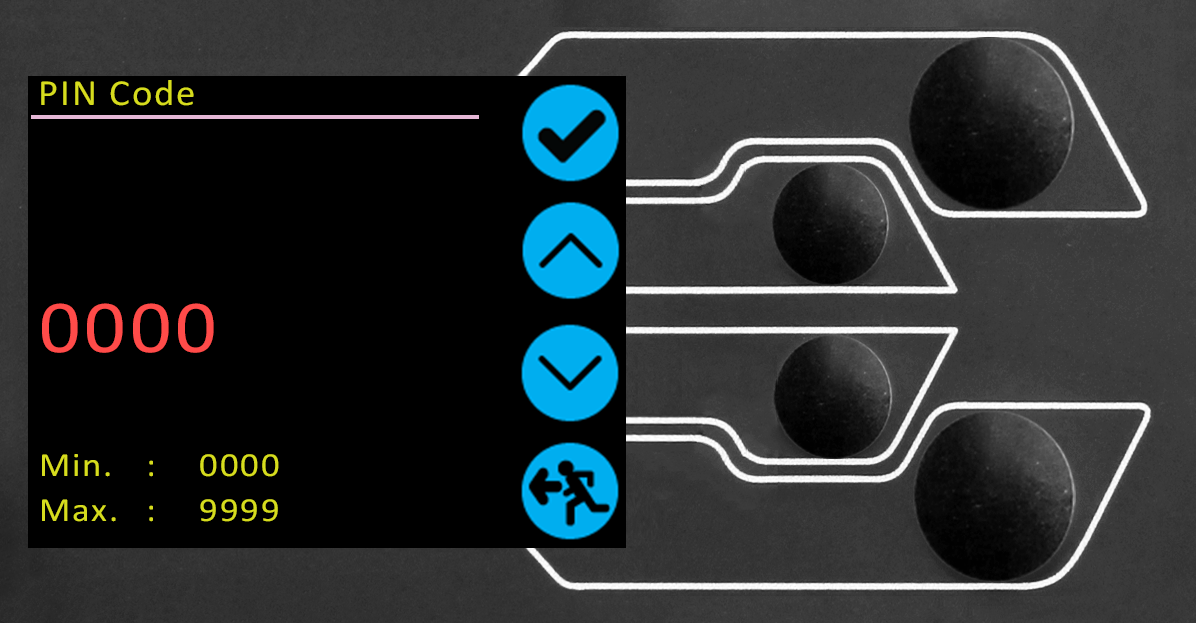
Within the PIN code menu, it is possible to set a four-digit number that can be used to lock the menu feature of your MultiTest-dV test stand. Please note once this has been set you cannot access the menu without the PIN, so it is crucial that you keep a record of this safe.
8.1.5 Languages
Select the desired language. Upon confirmation, the user is returned to the settings menu in the language chosen.
8.1.6 Information
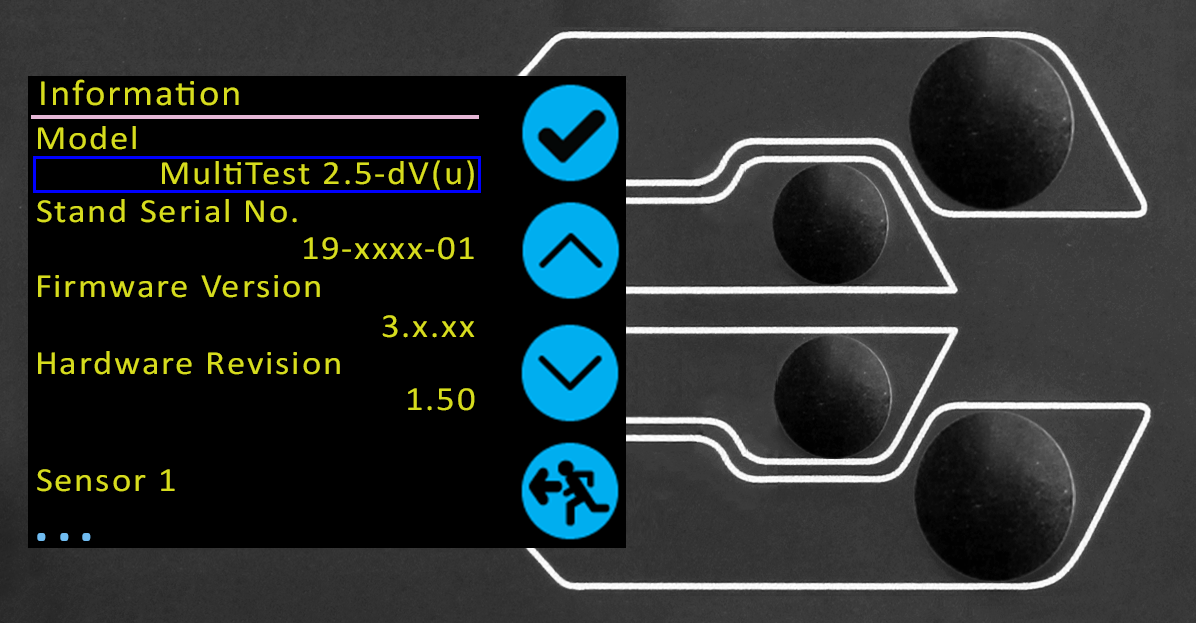
This screen is used to display vital information relating to the MultiTest-dV and connected devices. Here you can see software, hardware and firmware properties. If the stand is operating in dV(u) mode, the calibration date for ELS and the number of overloads that have occurred for the current ELS, is displayed.
8.2 Settings - MultiTest-dV(u) Operation
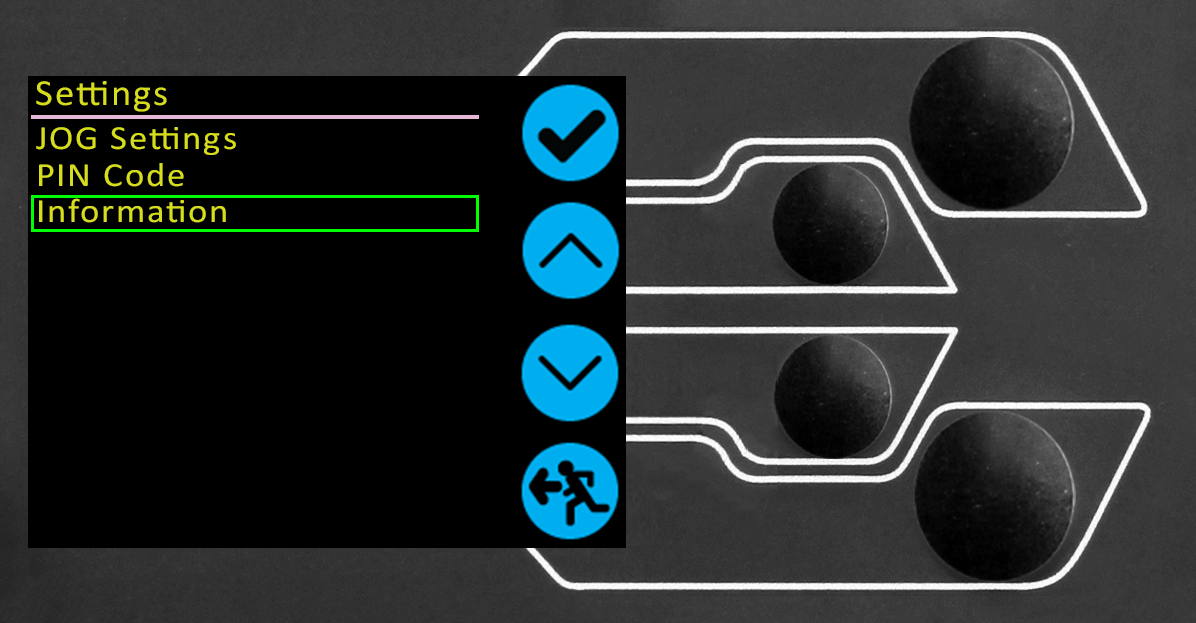
The settings listed below are for a MultiTest-dV being used in dV(u) mode, for standard dV operation see section Settings - MultiTest-dV Operation.
All settings are made by moving the selection marker to the required item or digit and confirming with the tick button or using the central scroll wheel button.
8.2.1 Jog settings
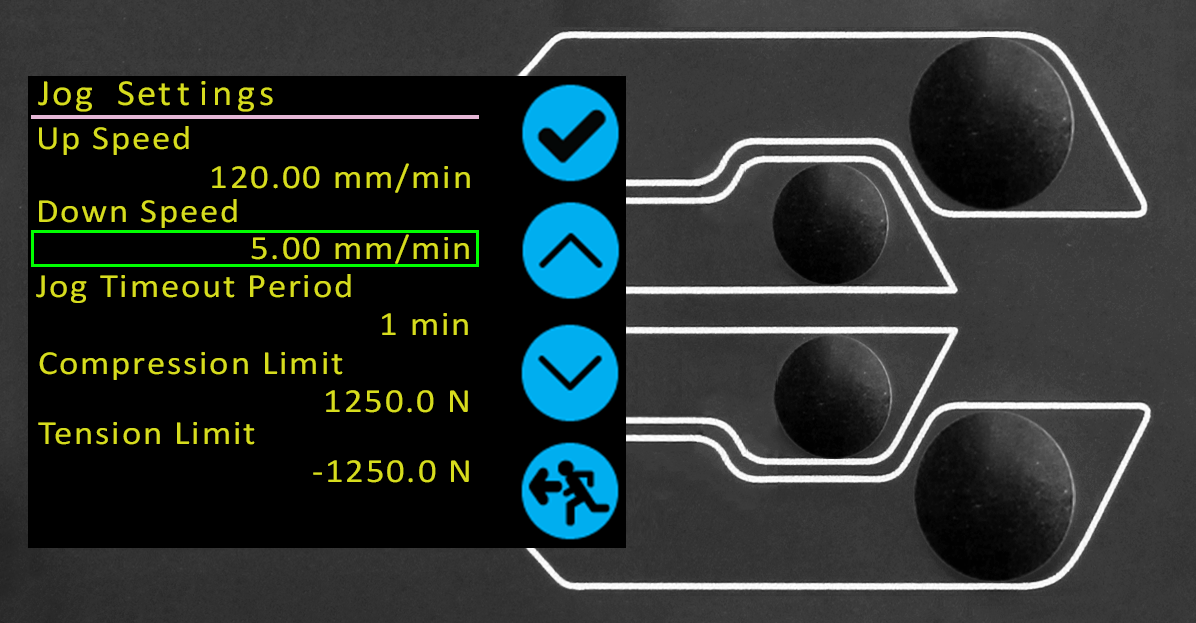
Within the jog settings menu, shown above, configuration of the jog speed limits while in jog mode, can be set. Below is a detailed breakdown of each setting and the options available for each setting.
|
Setting |
Action |
Range |
|---|---|---|
|
Up Speed |
Configure the jog speed in an upward motion |
0.1 to 1200 mm/min 0.004 to 47.24 Inch/min |
|
Down Speed |
Configure the jog speed in a downward motion |
0.1 to 1200 mm/min 0.004 to 47.24 Inch/min |
| Jog Timeout Period |
Set the timeout (in minutes) that the machine will keep the motor drive engaged, before the motor drive is disabled. The load applied to the ELS load cell and stand, must reach at least 25 % of the test stand's capacity before the timeout activation is applied. At the end of the timeout period, the 'Jog Active' menu screen is automatically switched back to the 'Ready to Test' menu screen. (Example: MultiTest-dV(u) 0.5 kN stand fitted with a 250 N ELS, must reach 125 N in Tension or Compression, before the timeout activation is applied. Forces below the 25 % limit will not activate the timeout and the stand will actively hold the load applied |
1 to 59 minutes |
|
Return Speed Up |
Configure the Return or Home speed from an initial downward driving direction |
0.010 to 1200 mm/min |
|
Return Speed Down |
Configure the Return or Home speed from an initial upward driving direction |
0.010 to 1200 mm/min |
|
Tension Limit |
Configure the tensile force limit while in jog mode |
0 to 125% ELS Capacity |
|
Compression Limit |
Configure the compressive force limit while in jog mode |
0 to 125% ELS Capacity |
8.2.2 PIN Code

Within the PIN code menu, it is possible to set a four-digit number that can be used to lock the menu feature of your MultiTest-dV test stand. Please note once this has been set you cannot access the menu without the PIN, so it is crucial that you keep a record of this safe.
8.2.3 Information

This screen is used to display vital information relating to the MultiTest-dV and connected devices. Here you can see software, hardware and firmware properties. If the stand is operating in dV(u) mode, the calibration date for ELS and the number of overloads that have occurred for the current ELS, is displayed.
9 Interlocked Guarding Overview
Mecmesin test stands have the ability to generate forces large enough to cause permanent injury to human limbs when placed between the crosshead and the base.
Fingers, hands and other parts of the body, or clothing, should be kept away from the moving crosshead and shroud opening. Appropriate personal protective equipment should be worn and full local risk assessments should have been completed before use.
Please refer to the Installation & Operation of Mecmesin Interlocked Machine Guarding (431-971) manual for full details of safety and operation.
From May 2020, all MultiTest-dV test stands will be supplied at a Mark 2 Interlock enabled level. This means they are electrically and mechanically ready to use with a Mecmesin supplied guarding system.
MultiTest-dV tests stands can be ordered with an interlock guard, or a supplementary guard can be ordered for an existing MultiTest-dV Mark 2. Please contact your Mecmesin sales representative or local approved supplier for more details.
9.1 Operating a MultiTest-dV Test Stand Without a Guard
MulitTest-dV test stands and their derivative models can be operated 'normally' without a supplied guard, for applications that do not warrant a guard to be used.
The stands have an 'Override' feature that allows an interlock override plug (part no. 351-102), supplied as an accessory to be fitted, that enables the use of the stand without a guard fitted. This plug will be supplied in the accessories and must be fitted to use the stand in normal operation.
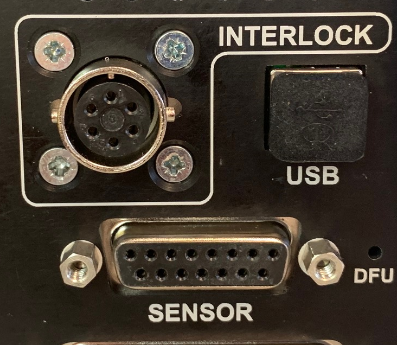 |
Interlock override plug (351-102) and Interlock rear panel connection on a Mark 2 Interlock enabled MultiTest-dV
The interlock plug is a simple twist-fit both on and off and is locked in place in a clockwsie direction. To fit, push the connector on with light pressure and turn clockwise. To remove, again apply light pressure and turn anti-clockwise.
With the override plug fitted, normal operation of the MultiTest-dV function and menus will be possible.
9.2 Operating a MultiTest-dV Test Stand With an Interlocked Guard
Mecmesin interlocked guarding is fitted with a cable and plug from the guard, that must be fitted to the rear of the stand panel 'Interlock' connection, in place of the removed override plug.
When a guard is fitted and connected to the MultiTest-dV, there is no need for any menu updates or user interaction to make it functional. The stand will have certain operations and user status warnings when the guard is opened and closed.
9.2.1 Guard Closed
With the guard door closed, normal menu displays and operations will be seen:
9.2.2 Guard Opened
9.2.2.1 With a Test Running
The guard door should never be opened whilst a test is running. Extremely high forces and energy can be present in the machine, grips or sample under test and personal injury or damage can occur.
Allow the machine to complete the test sequence or stop the machine manually and safely remove any residual loading before attempting to open the guard and access the machine, grips or sample under test.
9.2.2.2 MultiTest-dV Without PC Control
When running a MultiTest-dV standalone without VectorPro Lite software control, opening the guard will result in a test being aborted and the 'Interlock Active !' status message on the front panel display:
9.2.2.3 MulitiTest-dV With VectorPro Lite Control
When controlling the MultiTest-dV test stand with VectorPro Lite software functionality, the test stand front panel will behave with same actions as above.
The software will be aborted and the current test will not be recorded or stored. The software screen will briefly show the message shown below to indicate the guard had been opened during a test:

9.3 Operating a MultiTest-dV(u) Test Stand With an Interlocked Guard
There is only one exception to the interlock being activated when the guard is opened. If the machine is in dV(u) mode and is being controlled by VectorPro MT, using the 'Pause' timeline operations.
This allows the opening and closing of the guard without interruption to the test sequence, to allow such actions as fitting an accessory to the machine or measuring the sample under test.
9.3.1 VectorPro MT - Pause Operation
When using VectorPro in conjunction with an interlocked machine guard, the 'Pause' set of operations allow for the guard warnings to be overwritten. These timeline operations are in the ‘Pause’ section of VectorPro and they allow the door to be opened without aborting a test.
When a ‘Pause’ operation in the test timeline is reached, the test stand will stop and the window shown below is displayed onscreen. This indicates which button to press on the front panel to continue the test.
While the test is paused, the guard door may be opened and closed. Once ‘Play’ is pressed, the test will continue. If the door is left open when pressing ‘Play’, the test will immediately abort.
Opening the guard door without a software ‘Pause’ active will also operate the interlock circuit in the standard way.
During a ‘Pause’ operation, the following message will be displayed on the test stand’s front panel when opening the guard; ‘Interlock Active !’. This is shown in the image above.
For more information relating to ‘Pause’ operations, please read on from the section 'Pause Operations' of the 'VectorPro™ User Manual - Designing a Test MT Version'.
9.4 Clearing the Interlock Active Message
Apart from the 'Pause' function above, if the guard is opened at any time on the test stand, the ‘Interlock Active !' status message will be displayed and the scroll wheel indication will turn red:
To clear the message, do the following:
| Operation Type | Action | |
|---|---|---|
| 1 | Normal opening and closing of door (no test running) | Close the door and continue. |
| 2 | If a test is running and the door has been opened (test aborted) | Close the door. Press the 'Exit' button to return to the ready to test screen. Use jog mode to safely remove the residual load and then specimen. Or, press the 'Home' if it is safe to do so, to return to the ready to test screen. |
| 3 | Using VectorPro 'Pause' command | Press the 'Play' button once the guard has been closed to continue. Press 'Stop' button to abort the test. |
In cases 1 and 2 above, closing the door will change the status message to 'Interlock Opened' and the 'Home' and 'Exit' button icons will appear on the display:
When the 'Exit' button is pressed the ready to test screen is displayed and the operator can choose the next appropriate action.
When the 'Home' button is pressed, the stand will back to the set home or test start position and the ready to test screen is displayed and the operator can choose the next appropriate action.
In Case 3 above, the guard door can be opened and closed whilst the 'Pause' function is active.
Pressing the 'Play' button will advance the test sequence to the next operation and potentially the machine will start moving again.
Pressing the 'Stop' button will abort the test in both test stand and VectorPro software.
10 Automatic ELS Firmware Update
MultiTest-dV test stands with firmware 3.0.2 and above operating in dV(u) mode can update the firmware of any attached ELS device. This feature is managed through the front panel and ensures that the latest firmware version is loaded to the ELS device.
To start the update connect the ELS to the test system and then switch the test stand on.

Once the stand has powered on, the following screen will appear:
The new ‘Stored’ firmware is listed at the top of the display and the current ELS firmware is displayed below. In this instance the current firmware for the ELS is 1.08.000, starting the update will flash the device to version 2.1.000.
Please Note: Pressing the ‘Cross’ icon delays the upgrade. The upgrade can be started manually at a later time, by opening the information screen located within the settings menu and scrolling to the ELS firmware version.
This setting will have a ‘*’ next to it, pressing the ‘tick’ icon will open the firmware upgrade screen pictured above. If more than one ELS is connected (e.g. a load cell and a short analogue extensometer) the additional device will be listed below ELS 1.
To start the update of the first ELS device press the ‘tick’ icon.
The flashing of the device is carried out automatically and progresses through several stages.
In the image above initial programming is taking place. Progress can be monitored using the bar and percentage readout shown onscreen.
Within the final stage of the process, the firmware upgrade is verified to check that is has completed successfully.
Once the process is at 100%, the display will indicate that the firmware upgrade has been successful.
Either you will then be prompted to update the next ELS device currently connected or the display will return to the start screen if no additional ELS devices are connected.
11 Specification
| MultiTest-dV | |||||
|---|---|---|---|---|---|
| Rated Capacity | kN | 0.5 | 1 | 2.5 | |
| kgf | 50 | 100 | 250 | ||
| lbf | 110 | 220 | 550 | ||
| Displacement | |||||
| Crosshead Travel* | 1186mm (46.7”) | 986mm (38.8”) | 507mm (20”) | ||
| Maximum Headroom* | 1205mm (47.4”) | 1005mm (39.6”) | 526mm (20.7”) | ||
| Displacement Resolution | 1 µm (0.000025") | ||||
| Displacement Accuracy | ±0.130mm per 300mm travel (±0.005" per 11.81") | ||||
| Speed | |||||
| Speed Range† | mm/min | 0.1 to 1200 | 0.1 to 1200 | 0.1 to 1200†† | |
| in/min | 0.004 to 47.2 | 0.004 to 47.2 | 0.004 to 47.2 | ||
| Speed Accuracy (at steady state) | ±2% of indicated speed or ±20 μ/min whichever is greater**** | ||||
| Speed Resolution | 0.1mm/min (0.004"/min) | ||||
| Maximum Number of Cycles Per Test | 9999 (Cycling testing is not available in dV(u) mode) | ||||
| Dimensions | |||||
| Height | 1616 mm (64") | 1416 mm (56") | 941 mm (37") | ||
| Width | 290 mm (11.4") | 290 mm (11.4") | 290 mm (11.4") | ||
| Depth | 414 mm (16.3") | 414 mm (16.3") | 414 mm (16.3") | ||
| Vertical Daylight* | 1267 mm (49.9") | 1067 mm (42") | 588 mm (23.1") | ||
| Throat Depth** | 70.5 mm (2.8”) | 70.5 mm (2.8”) | 70.5 mm (2.8”) | ||
| Weight | 31 kg (68 lbs) | 27.5 kg (61 lbs) | 24 kg (53 lbs) | ||
| Electrical Supply | |||||
| Voltage | 230 V AC 50 Hz or 110 V AC 60 Hz | ||||
| Maximum Power Requirement | 120W | ||||
| Advanced Force Gauge (AFG), 10 models from 2.5 N to 2500 N | |||||
| Sensor Measurement Accuracy*** | 0.1% of full-scale | ||||
| Enhanced Load Sensors (ELS), 13 models from 2.5 N to 2500 N | |||||
| Sensor Measurement Accuracy | ±0.5% of reading down to 5% of range | ||||
| Environment Specification | |||||
| Operating Temperature | 10°C – 35°C (50°F – 95°F) | ||||
| Operating Relative Humidity | Normal Industry and laboratory conditions. (30% to 80% non-condensing) | ||||
| Display & Data Output | |||||
| Front Panel Display Indication | Load / Displacement / Speed | ||||
| Output of Test Results | Stand | Via USB (VectorPro™ Software - PDF, XLXS, CSV, TXT, Email and Images) | |||
| AFG/AFTI | Via Cable (contact: sales@mecmesin.com) | ||||
* Measured on centreline of gauge.
** Measured with a force gauge and short extension rod fitted.
*** Due to the variety of environmental conditions the device may be used in, this value does not include uncertainty of measurement.
**** Machine wear can be expected over time and may potentially adversely affect both speed and displacement measurement. Machine wear is dependent on factors such as the frequency of usage, harsh operating environments, and the types of test performed (e.g., sudden breaks of stiff materials may cause energy recoil which affects mechanical parts etc.). A full overhaul of the test frame may be required to bring the test system back to its original manufacturer’s specification.
† Where mains voltage is reliable
††2.5 kN : recommended maximum speed = 750 mm/min (30 in/min) above 2 kNm/min (30 in/min) above 2 kN.
12.2 MultiTest-dV 1.0kN Dimensions

12.3 MultiTest-dV 0.5kN Dimensions

